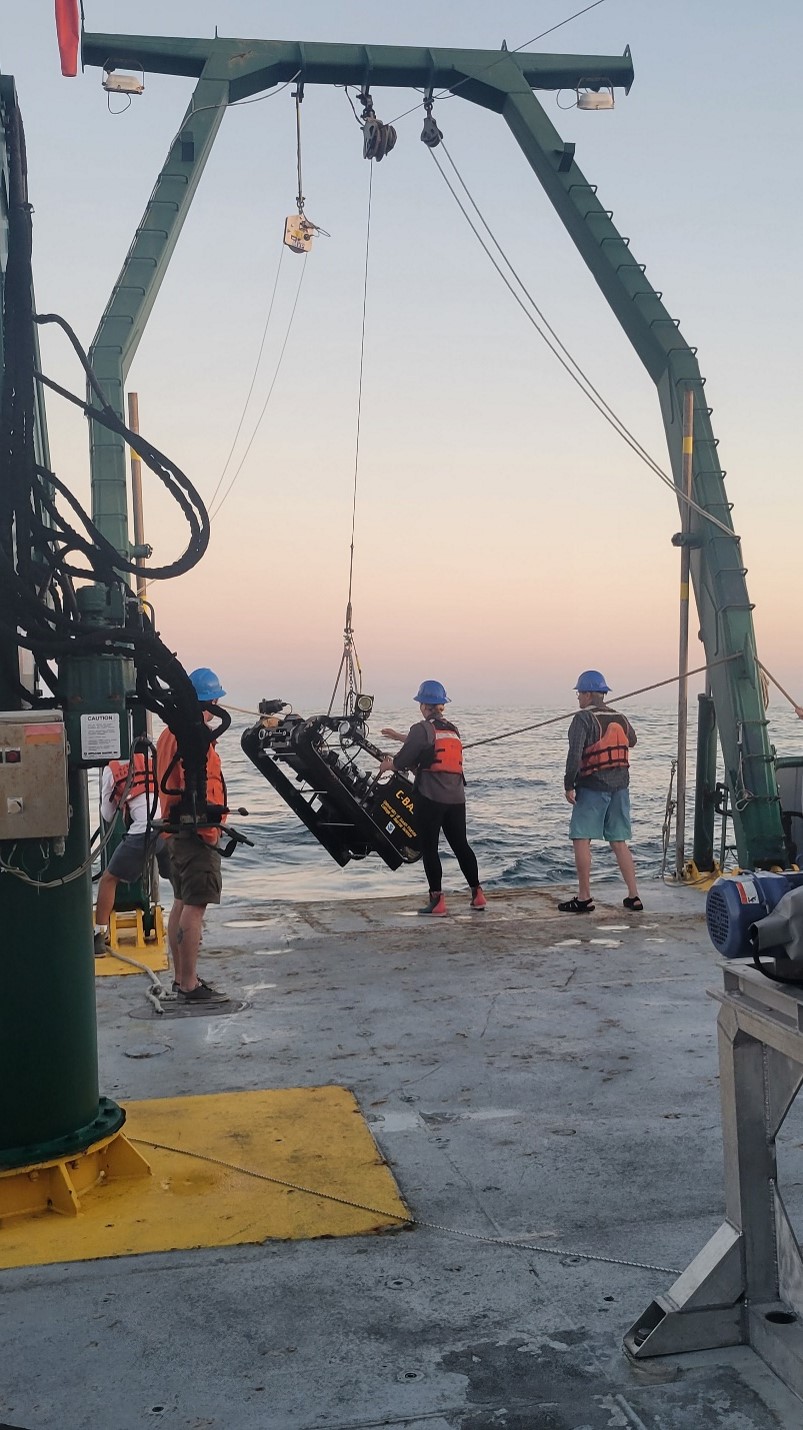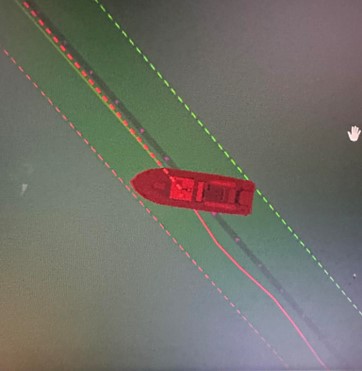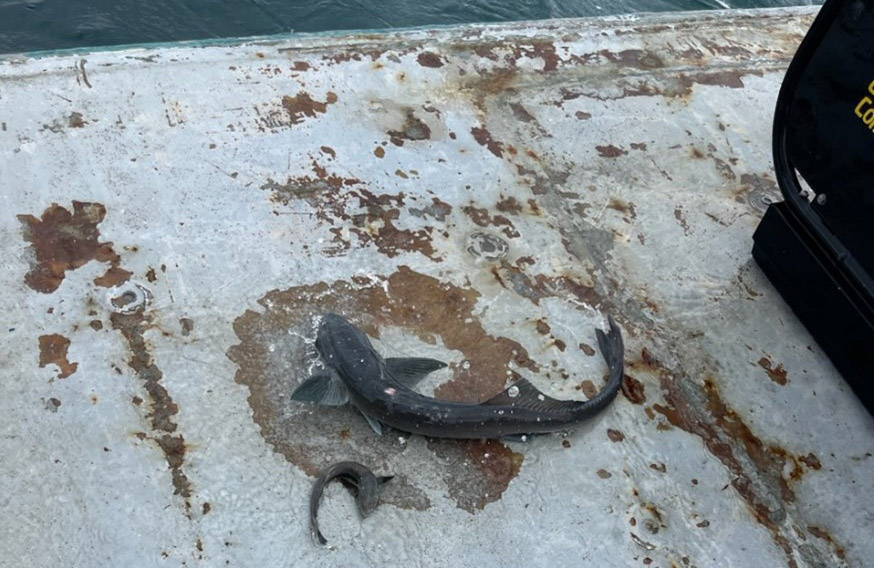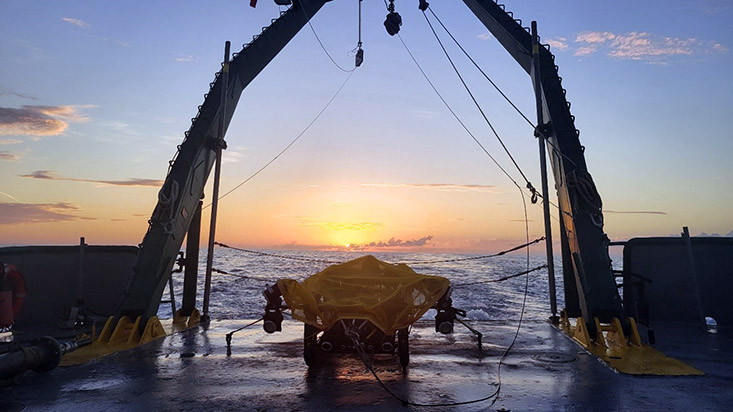By Sarah Grasty-Prueitt
There is a famous quote in fisheries science from Dr. John Shepard, who said, “Counting
fish is like counting trees, except they are invisible and keep moving.”
CMS’s Camera-Based Assessment Survey System (or C-BASS) team knows this adage all too well. We recently completed a 21-day research cruise aboard Florida Institute of Oceanography’s (FIO) vessel, R/V Weatherbird II, in search of Greater Amberjack (Seriola dumerili). This reef fish is the focus of a Mississippi-Alabama Sea Grant Consortium-funded project (via the NOAA National Marine Fisheries Service) that involves 13 institutions, each utilizing different gears and methods to sample Greater Amberjack in the Gulf of Mexico and South Atlantic.
Despite challenging weather, our group managed to collect dozens of hours of data
with the C-BASS and map hundreds of miles of seafloor using a multibeam bathymetry
system. We focused on the offshore regions between Port St. Lucie, FL and Morehead
City, NC in depths between 20 – 150 meters (60 – 500 feet). I served as chief scientist.

C-BASS being deployed on the R/V Weatherbird II. Image credit: Alex Ilich.
The C-BASS was tasked with focusing its sampling efforts in “unknown” areas where researchers aren’t sure what the seafloor looks like – sandy? rocky? muddy?
The answer? A whole lot of sand.
This translated into a just a handful of (treasured!) Amberjack sightings for our group as this species tends to prefer areas with bottom structure.
“Knowing where Amberjack aren’t is just as important as knowing where they are, especially considering the large geographic extent of our study,” says Steve Murawski, PhD, the PI for the C-BASS work on the project.
Each institution involved with the project provides a piece of the puzzle. Though C-BASS saw few Amberjacks, we collected hundreds of miles of habitat information during this effort which will greatly inform the project more broadly.
This cruise was the second of three that our team will complete in support of this project, but it was the most ambitious and logistically challenging. First, we had never deployed the C-BASS in the Atlantic and at certain times it can differ significantly from the Gulf of Mexico in terms of currents – a major consideration when you’re towing a 600-lb platform behind a boat full of cameras and computers.
Our group is happy to report that even in 4-5 knot current (compared to 1-2 knots
in the Gulf) the C-BASS performed well, even if it did mean at times that the ship
was moving nearly sideways to stay on the sampling lines. And second, with its home
port in St. Petersburg, FL, this plan took the Weatherbird II over 4,000 miles in those three weeks. When your max speed is about 10 mph, that’s
a tall order!

The R/V Weatherbird II is seen here “crabbing” which means that to keep a straight line, it had to be oriented at an angle to the strong currents. Image credit: Jason Politano.
Another first? Two remoras scored a ride on the C-BASS and stayed suctioned to the system even after it was brought on deck! Once detached the two hitchhikers were safely returned to the water.
The C-BASS team, with support from FIO, closes out our fieldwork in support of the Amberjack project at the end of July. The focus will be in the offshore region between Tampa Bay and the Florida Keys.

Remoras typically suction to other marine animals such as sharks and feed on their leftovers. These two remoras were almost certainly disappointed when they realized the C-BASS wasn’t going to provide them with any tasty meals. They were safely returned to the sea after detaching from the system. Image credit: Karah Kniola.
Lastly – this type of work takes a village and there are many thanks to go around! The CMS crew on this cruise included Harrison Clark, Matt Hommeyer, Alex Ilich, Karah Kniola, Chad Lembke, Stephan O’Brien, and Jill Thompson-Grim. FIO’s personnel included Captain Boomer Baumeister (now Assistant Marine Superintendent) and First Mate Jason Politano (now Captain) as well as Jordan Adams, Brian Kealy, Maggie Knott, Heather Meneses, Jake Smith, and Katie Von Dop.
